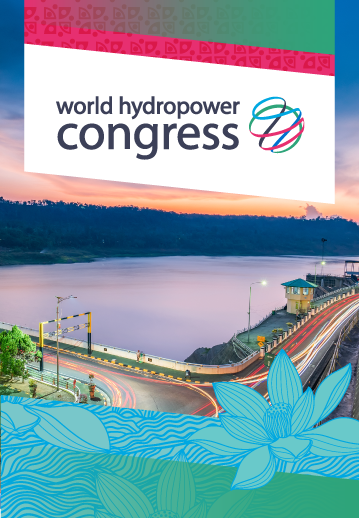With a population of well over a billion people and a fast growing economy, India’s electricity demand is expected to double over the next decade and hydropower will play a very important role.
India has close to 100 hydropower plants above 25 MW, plus nine pumped storage stations.
Hydropower’s share in the electricity mix has, however, been decreasing over the years, accounting for around 10 per cent of generation, with the majority (80 per cent) coming from thermal generation. The government formally recognised large hydropower as renewable in 2019. Previously, the government had considered projects up to 25 MW renewable, but in 2021 included hydropower in the Renewable Purchase Obligation.
India has an ambition to reduce its emissions intensity by 45 per cent and achieve 50 per cent cumulative electric power installed capacity from non-fossil fuel energy resources by 2030.
To compliment its variable renewable energy targets, India has indicated that it will need at least 18.8 GW of pumped hydropower capacity to support the integration of wind and solar by 2032 and potentially more if other energy storage systems are not financially viable. The government has identified that India has 100 GW of pumped storage potential from on-river, with more for off-river, with over 60 sites identified.
To support the development of this immense potential, India's Ministry of power constituted several committees to suggest ways and means to promote pumped storage hydropower (PSH) and form a comprehensive framework for development, policy and regulatory aspects, technology and financial and taxation issues. The first draft was shared in January 2022, with the Draft Guidelines to Promote Development of Pumped Storage Projects issued on 15 February 2023 which recognised PSPs invaluable grid services. India's Draft Guidelines sets out the financial mechanisms and policies to monetise the reliability and flexibility of PSPs. Additionally, the Guidelines set out potential tax and land exemptions that may also help to improve the financial viability of pumped hydropower projects.
IHA welcomes these guidelines and commends India for their leadership in market and policy innovations to enable this vital technology.
Read IHA's response.

Hydropower projects have previously faced delays due to complex planning procedures, prolonged land acquisition and resettlement, a lack of enabling infrastructure including transmission, insufficient market scope and long-term financing. In addition to the PSP Guidelines, India has introduced many measures to help. In February 2022, a clarification on the status of energy storage systems was issued by the Ministry of Power on how it would help to achieve national renewable energy goals. In July 2022, the Energy Storage Obligation was issued alongside the Renewable Purchase Obligation for the first time and indicated that at least 85 per cent of the energy procured and stored on an annual basis must come from renewable energy sources. In 2021, to further support hydropower, the government provided budgetary support towards the costs of enabling infrastructure, e.g. roads and bridges, for hydropower and pumped storage projects. Prior to recent policies, significant reforms included the 2008 Hydro Power Policy encouraging private sector participation and the 2016 National Tariff Policy on frequency response markets and extended certainty of power purchase agreements.
The Central Electricity Authority (CEA) and Ministry of Power have also been actively monitoring and fast-tracking priority schemes, notably the 50,000 MW Hydro Electric Initiative. Draft policies under preparation are expected to support stalled hydropower projects and private sector uptake and could include measures to make hydropower tariffs more competitive.
Numerous hydropower projects are at early development stages across the country, including the 300 MW Lakhwar multipurpose project, first conceptualised in the 1970s; in December 2021, Prime Minister Modi, laid the foundation stone at the site. The same month, India's cabinet approved Ken-Betwa, the first project for interlinking rivers under the National Perspective plan to help drought areas, which will include a 106 MW hydropower facility.
In 2020, the country’s hydropower sector was heralded for restoring electricity to tens of millions following a huge plunge in demand.
In 2019, the Teesta-V hydropower station in Sikkim was rated as an example of international good practice in hydropower sustainability, following an independent assessment.
As a country profoundly impacted by climate change, India's monsoon season is immensely important to agriculture and electricity generation from hydropower. In 2022, during its monsoon season, India experienced increased record rainfalls, which led to increased generation from its hydropower assets and replenished water storage. Generation increased significantly compared to 2020 and 2021 annual years, a 13.2 per cent increase from 2021. Prior to the June rain, India had been experiencing severe temperatures after its hottest March on record.







